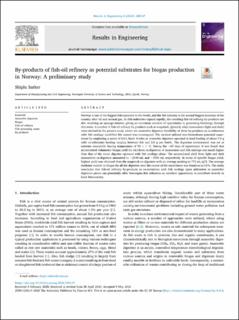| dc.contributor.author | Sarker, Shiplu | |
| dc.date.accessioned | 2020-06-02T07:24:24Z | |
| dc.date.available | 2020-06-02T07:24:24Z | |
| dc.date.created | 2020-03-02T12:03:14Z | |
| dc.date.issued | 2020 | |
| dc.identifier.issn | 2590-1230 | |
| dc.identifier.uri | https://hdl.handle.net/11250/2656075 | |
| dc.description.abstract | Norway is one of the biggest fish exporters in the world, and the fish industry is the second biggest economy of the country after oil and natural gas. As fish industries expand rapidly, the resulting fish-oil refining by-products are also receiving an upsurge interest, giving an enormous window of opportunity in generating bioenergy through this route. A number of fish-oil refinery by-products such as soapstock, glycerol, ethyl monoesters (light and dark) were utilized in the present study where the anaerobic digestion feasibility of these by-products as co-substrates with fish ensilage (acidified fish waste) was investigated. The method utilized was biomethane potential experiment by employing a series of 0.5 L batch bottles as anaerobic digesters operated at total feeding of about 7.0 g with co-substrates feeding ranging between 0.6 and 2.0 g per bottle. The digestion environment was set at extreme mesophilic having temperature of 39 ± 1 °C. During the ~65 days of experiment, it was found that accumulated volumetric biogas yield (in mL) from co-digestion of monoesters and fish ensilage was much higher than that of the mono digester operated with fish ensilage alone. The accumulated yield from light and dark monoesters co-digesters amounted to ~2100 mL and ~1950 mL respectively. In terms of specific biogas yield, highest yield was obtained from the soapstock co-digesters with an average peaking to 775 mL/gTS. The average methane content in biogas for all the digesters over the course of the experiment was found as ca 61%. The study concludes that fish-oil refinery by-products as co-substrates with fish ensilage upon utilization to anaerobic digestion plants can potentially offer Norwegian fish refineries an excellent opportunity to contribute heavily in local bioeconomy. | en_US |
| dc.language.iso | eng | en_US |
| dc.publisher | Elsevier | en_US |
| dc.rights | Navngivelse 4.0 Internasjonal | * |
| dc.rights.uri | http://creativecommons.org/licenses/by/4.0/deed.no | * |
| dc.title | By-products of fish-oil refinery as potential substrates for biogas production in Norway: a preliminary study | en_US |
| dc.type | Peer reviewed | en_US |
| dc.type | Journal article | en_US |
| dc.description.version | publishedVersion | en_US |
| dc.source.volume | 6 | en_US |
| dc.source.journal | Results in Engineering (RINENG) | en_US |
| dc.identifier.doi | 10.1016/j.rineng.2020.100137 | |
| dc.identifier.cristin | 1798892 | |
| dc.description.localcode | DOI:10.1016/j.rineng.2020.100137 Received 4 February 2020; Received in revised form 30 April 2020; Accepted 9 May 20202590-1230/©2020 The Author(s). Published by Elsevier B.V. This is an open access article under the CC BY license (http://creativecommons.org/licenses/by/4.0/) | en_US |
| cristin.ispublished | true | |
| cristin.fulltext | original | |
| cristin.qualitycode | 1 | |

